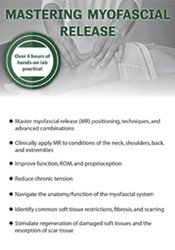Garry Adkins – Mastering Myofascial Release
$219 Original price was: $219.$62Current price is: $62.
Shopping Instructions:
- DISCOUNT 15% : SHOP15
- Product Delivery: Within 1 – 12 hours after purchase.
Fascial tissue can become rigid, and inelastic over time, due to physical and emotional trauma, habit patterns, disease, and the desiccation of tissue that can accompany the aging process.
Garry Adkins – Mastering Myofascial Release
Fascial Anatomy, Function, and Behavior
- What we know
- What we have learned lately
Lab: Assessment Techniques for Identifying Fascial Restrictions, Scarring, and Fibrosis
Principles and Procedures
- Myofascial torso techniques
- Palpation skills tune-up
- Comparing other forms of myofascial release
Lab: Utilizing Myofascial Release and Incorporating Effective Posture
- Position to provide most efficient therapist posture
- Support of the spine and extremities
- Cross grain compared to with grain
- Tissue barrier and beyond
- Cross-hand releases
- Longitudinal plane releases
- Compression releases
- Transverse plane releases
- Myofascial unwinding
- Myofascial rebounding
Indications and Contraindications
Lab: Advanced Myofascial Release Combinations and Manual Sequencing
- Combining techniques
- Manual sequence
- Palpatory assessment utilizing proprioception
- Tissue mobility, motility, and glide
- Traction and compression
- Skin rolling and rebounding
Lab: Mastering Myofascial Release – Clinical Applications and Customizations
- Treatments for head and neck conditions
- Treatments for shoulder and upper extremity conditions
- Treatments for back and lower extremity conditions
Home Exercises
Case Studies and Fascia Research
Would you like to receive Garry Adkins – Mastering Myofascial Release ?
Description:
Fascial tissue can become rigid, and inelastic over time, due to physical and emotional trauma, habit patterns, disease, and the desiccation of tissue that can accompany the aging process. In short, fascial tissue will change from a lubricant to an adhesive. This binding up of fascial tissue causes a great deal of what the patient experiences as stress, tension, pain, and reduced range of motion.
In this recording, we’ll focus on techniques and treatment protocols that immediately reduce chronic tension and improve range of motion with minimal residual soreness the next day. Discover a myofascial treatment approach that utilizes gentle pressure to increase client proprioception while allowing fascia to gently lengthen, stretch, soften, and become more flexible. Learn how myofascial release enables clinicians to efficiently locate and treat scar tissue and adhesions that cause multi–layered soft tissue restriction and adversely affect the dynamic function of the underlying muscles, tendons, fascia, and ligaments. Finally, explore how using less pressure can improve your mechanical advantage and empower you to treat fascia more deeply and effectively.
Related products
HEALTH & MEDICAL
HEALTH & MEDICAL
HEALTH & MEDICAL
HEALTH & MEDICAL
Regina Meredith – Conscious Media Network with Regina Meredith – Eric Pearl on The Reconnection
HEALTH & MEDICAL
HEALTH & MEDICAL












